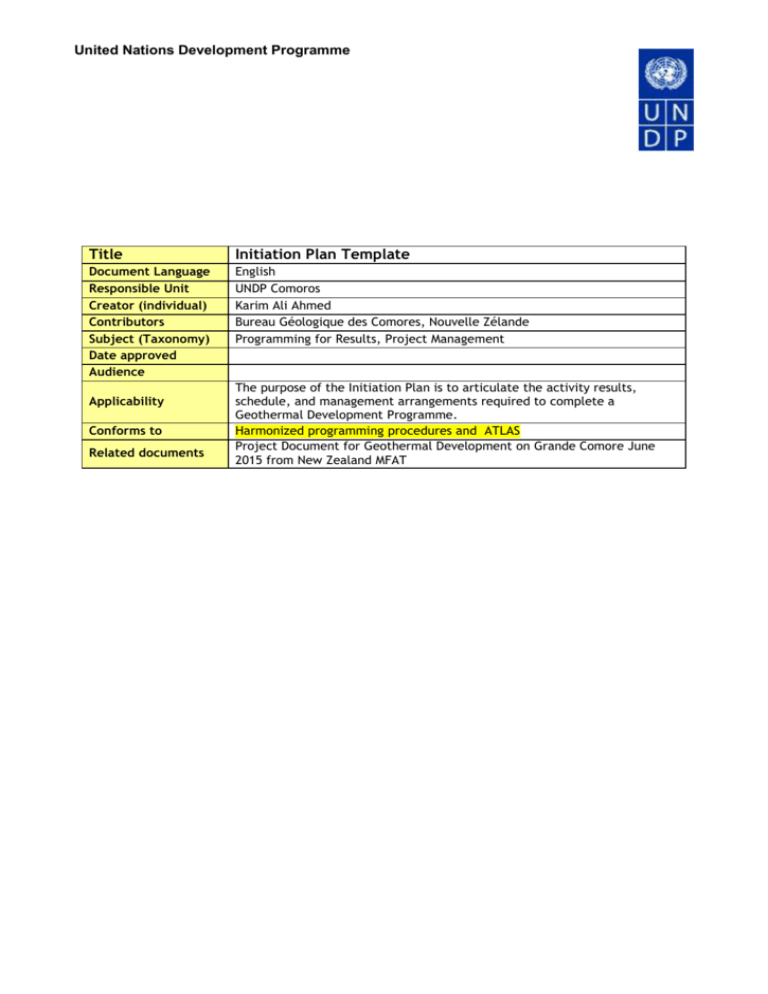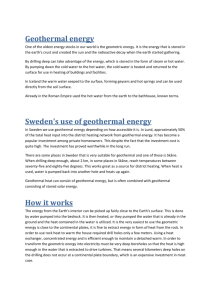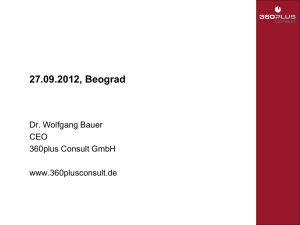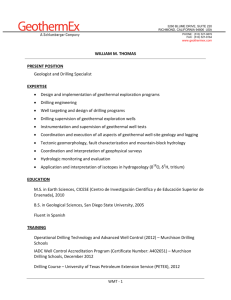The preparation of a recommended drilling strategy and
advertisement

United Nations Development Programme Title Initiation Plan Template Document Language Responsible Unit Creator (individual) Contributors Subject (Taxonomy) Date approved Audience English UNDP Comoros Karim Ali Ahmed Bureau Géologique des Comores, Nouvelle Zélande Programming for Results, Project Management Applicability Conforms to Related documents The purpose of the Initiation Plan is to articulate the activity results, schedule, and management arrangements required to complete a Geothermal Development Programme. Harmonized programming procedures and ATLAS Project Document for Geothermal Development on Grande Comore June 2015 from New Zealand MFAT United Nations Development Programme Country: Initiation Plan Project Title: Sustainable Development of the Union of Comoros through the promotion of Geothermal and other types of renewables Expected CP Outcome(s): Le pays dispose du cadre politique, juridique et réglementaire pour la promotion et le développement des énergies renouvelables Expected Output(s): Promouvoir les énergies renouvelables et faciliter la mise en place d'une première centrale géothermique (Those that are linked to the project and extracted from the CPAP) Initiation Plan Start Date: July 2015 Initiation Plan End Date: June 2016 Implementing Partner: United Nations Development Programme Programme Period: 2015-2019 Total resources required US$127,000 Total allocated resources: US$127,000 CPAP Programme Component: ______________ Atlas Award ID: ______________ PAC Meeting Date ______________ Agreed by UNDP: Donor of funds GRMF US$127,000 I. PURPOSE Grande Comore Island (also known as Njazidja) is the most populous of the Comoros Islands that lie in the northern part of the Mozambique Channel between Africa and Madagascar. It is the site of active volcanism at the Karthala volcano that occupies the southern portion of the island. Karthala has formed by “hot spot” volcanism, similar to that found in the Hawaiian Islands, where there is a geothermal power plant operating and a large inferred resource has been identified. The key indicator of a potentially exploitable geothermal system on Grande Comore is the presence of a rift system associated with the active volcano. This type of rift, which is similar to that providing energy for the Hawaiian project, could host thermal activity at depth suitable for targeting by drilling. This geological structure, observed surface thermal discharges and an initial geophysical survey undertaken by KenGen in April 2008, suggest that an active geothermal system is present. The recent surface exploration has reinforced this interpretation. For there to be an exploitable resource it is important that not only is there a heat source but that the geological structure is such that it provides an impermeable “cap” that sits above any reservoir to provide a pressure seal; beneath this cap there should be a source of fluids which are derived from the ingress of ground waters over a considerable period. The process of drilling provides a conduit from the surface to the reservoir below the cap allowing high temperature geothermal fluids to be extracted for energy production. In summary, with good indicators of a useful geothermal resource being present, the potential for developing this resource to displace expensive existing generation means that the project is worthy of continued investigation. The main expected result of Phase I Initiation Plan is an Integrated Resource Assessment and an Exploratory Drilling Strategy, through: II. The conduct of a multi-disciplinary assessment of the results of all surveys and existing data. The development conceptual hydrothermal models of the system/s. The report of studies results in the form of an integrated resource assessment. The preparation of a recommended drilling strategy and plan. This will include assessment of what must be achieved by drilling to confirm the geothermal concept model with consideration to drilling logistics and costs. Drilling strategy, decision points, well targets, concept well design. EXPECTED OUTPUTS 1. Specific Plan for Current Surface Exploration at Grande Comore The following sections outline the tasks that have been undertaken during the first phase of the thorough surface exploration and the geophysical work that is about to begin using a staged process to systematically assess project viability. Initial work involves a combination of desktop review and field surveys. 2. Surface Exploration Studies Geoscientific Data Review and Fieldwork Preparation The main objective of the current exploration programme is to determine the key resource characteristics of any Karthala and/or associated geothermal system, including its size, depth, temperature and fluid chemistry, and the nature of permeability. Fieldwork A programme of geoscientific fieldwork is being completed to expand on preliminary reconnaissance work undertaken by KenGen and others. The objective of this fieldwork is to visit and, as appropriate, sample thermal features and become familiar with the local geology to improve the understanding of the likely nature and extent of the geothermal resource. In conjunction with the geophysics (see below) the geoscientific information collected will be used to develop an integrated conceptual model of the resource and assist with the development of an exploration drilling strategy. Geophysical Survey (MT survey) Following the initial geoscientific review, geophysical surveying is to assist with the delineation of the geothermal resource/s. The following activities are required to undertake a Magneto telluric (MT) survey on Grande Comore (Karthala and La Grille). Plan a nominal 60 to 100 station MT resistivity survey: (i) Complete the primary MT data acquisition and 3D modelling; (ii) Supervise the MT survey, modifying the survey based on interim results; Keep a flexible approach to survey layout and adjust survey cover to maximise the benefit from the survey; (iii) Model and interpret the MT data using 1D, 2D and 3D methods as appropriate; (iv) The results of the MT modelling will be integrated with all other data to update the resource conceptual model and plan an exploration drilling strategy (below). 3. Project Definition: Project Concept Report A preliminary Project Concept Report or Pre-Feasibility study will be prepared to define the potential development objectives, describe what the project may look like, and provide an initial assessment of potential constraints and opportunities. The Project Concept Report would also describe conceptual level resource development and infrastructure requirements, technology alternatives, and concept level cost estimates for steamfield and power plant engineering. Social and commercial factors including legal rights to the resource, regulatory considerations, potential power sales agreements should also be considered at this point. This task would be undertaken as results of the surface exploration activities become available. A study of this nature will be needed as a step towards financial justification of the high costs for exploration drilling. III. MANAGEMENT ARRANGEMENTS UNDP will coordinate and manage Phase I of the Geothermal Initiative. Following the development of the geoscientific and geophysics studies and drilling strategy plan during phase I, the programme parties (NZ, UA/GRMF, BGC, and UNDP) will design Phase II by developing a final programme implementation plan. UNDP would advise during this process to determine programme scope and objectives, programme organisation, governance, and implementing agencies. The development of an implementation plan will be organised as a one day workshop in order to secure a transfer of knowledge and insights from the external consultancy to the programme implementation structure. The implementation structure board meeting will have its own budget although UNDPs advice during the implementation structure meeting will be part of this Initiation Plan. In order to focus resources and make sure that important considerations from the programme parties are met, detailed key performance indicators and corresponding annual targets should be established. Select implementing partners UNDP, BGC and ICI will be response ble for the implementation of the final programme. The role of each organisation, as well as the selection of local implementing partners, will be determined by the Task Force after having decided the scope and desired outcomes for the programme. Roles and responsibilities of the implementing partners will be described as part of the final programme document to be decided by the programme partners. When possible, structures established by the government of Côte d’Ivoire should be used as the main vehicle for implementing the activities in order to strengthen lasting capacity on the ground. IV. MONITORING The project baseline document and strategy will be submitted for review by the International Consultant and approved by GCF RTA (Green Commodity Facility, regional Technical advisor) and UNDP CO. V. ANNUAL WORK PLAN The activities listed below will form the main outputs for Phase I studies and strategy development. To assist in achieving the listed outputs UNDP will facilitate and drive the initiative while bringing in and coordinating other relevant stakeholders. All output activities listed below support the Comoros programme for surface explorations and exploration drillings to help develop geothermal energy production. EXPECTED OUTPUTS Activities and results Output 1: Geothermal Surface Exploration in Comoros Conduct a multi-disciplinary assessment of the results of all surveys and existing data. Development conceptual hydrothermal models of the system/s. Report of studies results in the form of an integrated resource assessment. Prepare a recommended drilling strategy and plan. This will include assessment of what must be achieved by drilling to confirm the geothermal concept model with consideration to drilling logistics and costs. Drilling strategy, decision points, well targets, concept well design. Budget Description Budget notes Field equipment e.g. tents, sleeping mats, backpacks, sleeping bags, hiking boots, portable generators & fuel. Camp supplies e.g. Food and water supplies for camp personnel, generators, fuel, batteries, torches. Transport, shipping, & handle Vehicle hire - 2 x4WDs + fuel Local guides/porters required to carrying equipment, supplies, camp support, cooks Output 3: Project formulation for Phase 2 TOTAL (US$) Formulate and present a draft project document I report to CCP board including strategy for Phase II Meetings to share the findings of the surface study. This workshop will be used to ensure that all stakeholders are aware of challenges identified and mobilise partners for financial support to next phases of the Initiative. Follow up stakeholder consultations for environmental strategy Amount (US$) 26,000 15,000 66,000 Mandatory Insurances DSA budget for up-country visits by national consultants 20,000 PM PM 127,000







